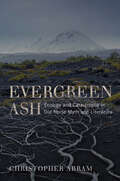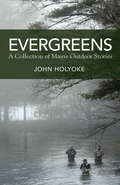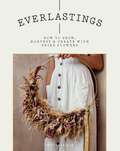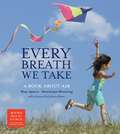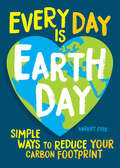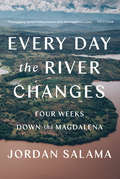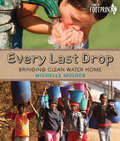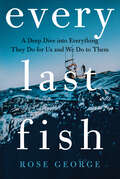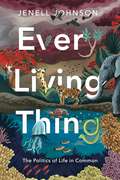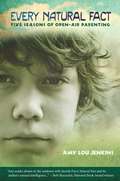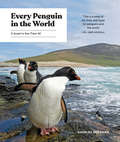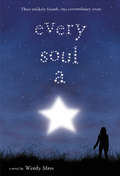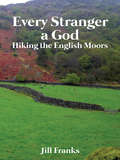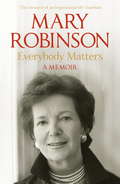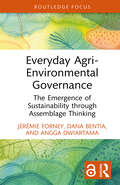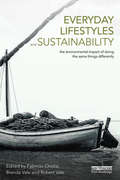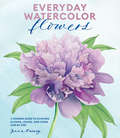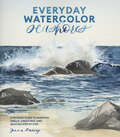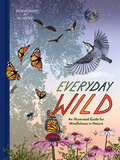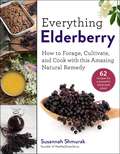- Table View
- List View
Evergreen Ash: Ecology and Catastrophe in Old Norse Myth and Literature (Under the Sign of Nature)
by Christopher AbramNorse mythology is obsessed with the idea of an onrushing and unstoppable apocalypse: Ragnarok, when the whole of creation will perish in fire, smoke, and darkness and the earth will no longer support the life it once nurtured. Most of the Old Norse texts that preserve the myths of Ragnarok originated in Iceland, a nation whose volcanic activity places it perpetually on the brink of a world-changing environmental catastrophe. As the first full-length ecocritical study of Old Norse myth and literature, Evergreen Ash argues that Ragnarok is primarily a story of ecological collapse that reflects the anxieties of early Icelanders who were trying to make a home in a profoundly strange, marginal, and at times hostile environment.Christopher Abram here contends that Ragnarok offers an uncanny foreshadowing of our current global ecological crisis—the era of the Anthropocene. Ragnarok portends what may happen when a civilization believes that nature can be mastered and treated only as a resource to be exploited for human ends. The enduring power of the Ragnarok myth, and its relevance to life in the era of climate change, lies in its terrifying evocation of a world in which nothing is what it was before, a world that is no longer home to us—and, thus, a world with no future. Climate change may well be our Ragnarok.
Evergreens: A Collection of Maine Outdoor Stories
by John HolyokeThere is nothing that outdoors columnist John Holyoke loves more than a good story. In his first book, Evergreens, Holyoke shares a curated collection of essays featuring people who are passionate about the outdoors, as well as his memorable encounters with creatures—from salmon to deer to moose to squirrels—that fascinate and confound him. Sprinkled throughout are memories of the events that have shaped him as he recounts the benefits of spending time with friends in the woods, fields, and waters of Maine. As Holyoke says, “I am here to take you on an adventure. Along the way, you’re welcome to laugh, cry, or smile, or reach for the phone to call an old friend and tell them that they still matter.”
Everlastings: How to Grow, Harvest and Create with Dried Flowers
by Bex PartridgeEverlastings is a celebration of the life of flowers, showcasing the ethereal beauty of dried flowers. Bex Partridge takes you on a journey, starting with practical advice on how to pick flowers both at your home and outdoors, with in-depth descriptions of the many methods of drying blooms, seed heads and foliage, before sharing her favourite ways to style with dried flowers in the home as well as wearable items such as floral crowns and hair clips. The main section of the book features over 20 projects to try at home, all accompanied with beautiful photography. Suitable for both those that have never worked with dried flowers before and the seasoned professionals, the projects span many levels of experience. Bex shares ideas on how to capture the memories and moments of special days, through the gathering and preserving of flowers, to be treasured for years to come. She also shares her knowledge of the ecological benefits of dried flowers, as well as chapters on foraging and thoughts on the meditative benefits of working with dried flowers. Filled with stunning imagery that Bex has become known for online, Everlastings presents a modern take on an age-old craft.
Every Breath We Take: A Book About Air
by Dominique Browning Maya AjmeraClean air is essential for all living creatures—plants, animals, and people—to live healthy lives. Every Breath We Take is a positive, life-affirming look at clean air, with a subtle message about how air can be dirtied—and how it can be cleaned up. Photographs of beautiful children around the world exploring air through touch, smell, sound, and sight underscore the importance of clean air to all life on earth. This is science that surrounds us.The first step to cherishing something is recognizing its importance and understanding why it is necessary. A portion of the proceeds from the sales of this book will be donated to Moms Clean Air Force, a national movement of over a half million moms, dads, and grandparents who are protecting the right of every child to breathe clean air.
Every Day Is Earth Day: Simple Ways to Reduce Your Carbon Footprint
by Harriet DyerFast facts on fast fashion, throwaway plastics, and other climate catastrophes that you can do something about—today. Every Day Is Earth Day is full of simple ways to reduce your environmental impact. From tips on creating a more eco-friendly home and ways to reduce your plastic use, to advice on shopping sustainably, within these pages you will discover everything you need to know to help you make planet-friendly choices and live a more sustainable life. Also included are tips on taking it to the next level and becoming an activist—to effect wider change and encourage businesses and governments to create a future that&’s healthier, safer, and cleaner!
Every Day the River Changes: Four Weeks Down the Magdalena
by Jordan SalamaAn exhilarating travelogue for a new generation about a journey along Colombia&’s Magdalena River, exploring life by the banks of a majestic river now at risk, and how a country recovers from conflict.An American writer of Argentine, Syrian, and Iraqi Jewish descent, Jordan Salama tells the story of the Río Magdalena, nearly one thousand miles long, the heart of Colombia. This is Gabriel García Márquez&’s territory—rumor has it Macondo was partly inspired by the port town of Mompox—as much as that of the Middle Eastern immigrants who run fabric stores by its banks. Following the river from its source high in the Andes to its mouth on the Caribbean coast, journeying by boat, bus, and improvised motobalinera, Salama writes against stereotype and toward the rich lives of those he meets. Among them are a canoe builder, biologists who study invasive hippopotamuses, a Queens transplant managing a failing hotel, a jeweler practicing the art of silver filigree, and a traveling librarian whose donkeys, Alfa and Beto, haul books to rural children. Joy, mourning, and humor come together in this astonishing debut, about a country too often seen as only a site of war, and a tale of lively adventure following a legendary river.
Every Last Drop: Bringing Clean Water Home (Orca Footprints)
by Michelle MulderIn the developed world, if you want a drink of water you just turn on a tap or open a bottle. But for millions of families worldwide, finding clean water is a daily challenge, and kids are often the ones responsible for carrying water to their homes. Every Last Drop looks at why the world's water resources are at risk and how communities around the world are finding innovative ways to quench their thirst and water their crops. Maybe you're not ready to drink fog, as they do in Chile, or use water made from treated sewage, but you can get a low-flush toilet, plant a tree, protect a wetland or just take shorter showers. Every last drop counts!
Every Last Fish: A Deep Dive into Everything They Do for Us and We Do to Them
by Rose GeorgeA fresh and fascinating take on fish, the fishing industry, and our shared future, from one of our most intrepid and entertaining nonfiction writers. Slippery, wet, and strange: Fish can be easier to think of as food than as fellow animals. But what do we know about these creatures we meet on our dinner table and how they got there? For the first time in history, humans are eating more farmed fish than wild, and our fish consumption is predicted to increase. But with warming oceans, diminishing fish stocks, and questions about fish farming practices, where will the fish come from? In Every Last Fish, Rose George dives into these questions by exploring the vast industries that support our appetite for fish sticks and salmon burgers, and the colossal illegal fishing trade whose practices and standards are unmonitored and often dangerous. Journeying to the bottom of the ocean and back, she examines the machinations of this $200 billion food system—one that’s growing rapidly even as fish populations disappear. Along the way, George introduces us to the people on the front lines of fishes and fishing: fishermen, divers, marine biologists, fish fryers, and fishwives. She presents minnows who shout; discovers the underwater soap operas of wolffish; and, despite her constant seasickness, boards trawlers to see firsthand the impact of fishing on our emptying oceans. Her journey ends at the fish counter, with guidance for readers looking to make better choices, both for the ocean’s health and their own. Ranging from Alaska to the United Kingdom to Senegal and beyond, Every Last Fish is an unforgettable trip through the ocean’s inhabitants and workers. With irresistible wit and an eye for the unusual, George reveals the unseen and endangered world behind what you buy at the seafood counter, while also bringing to life that dead fish on your plate.
Every Living Thing: The Politics of Life in Common (RSA Series in Transdisciplinary Rhetoric)
by Jenell JohnsonThis book examines the question of what we mean when we talk about life, revealing new insights into what life is, what it does, and why it matters. Jenell Johnson studies arguments on behalf of life—not just of the human or animal variety, but all life. She considers, for example, the Standing Rock Sioux tribe’s fight for water, deep ecologists’ Earth First! activism, the Voluntary Human Extinction Movement, and astrophysicists’ positions on Martian microbes. What she reveals is that this advocacy—vital advocacy—expands our view of what counts as life and shows us what it would mean for the moral standing of human life to be extended to life itself.Including short interviews with celebrated ecological writer Dorion Sagan, former NASA Planetary Protection Officer Catharine Conley, and leading figure in Indigenous and environmental studies Kyle Whyte, Every Living Thing provides a capacious view of life in the natural world. This book is a must-read for anyone interested in biodiversity, bioethics, and the environment.
Every Man For Himself: Shortlisted for the Booker Prize, 1996 (Bainbridge, Beryl Ser.)
by Beryl BainbridgeWINNER OF THE WHITBREAD PRIZE FOR FICTION 1996WINNER OF THE COMMONWEALTH WRITERS' PRIZE 1997'A narrative both sparkling and deep . . . the cost of raising [the Titanic] is prohibitive; Bainbridge does the next best thing' Hilary Mantel'Brilliant . . . do not miss this novel' Daily Telegraph'A moving, microcosmic portrait of an era's bitter end' The TimesFor the four fraught, mysterious days of her doomed maiden voyage in 1912, the Titanic sails towards New York, glittering with luxury, freighted with millionaires and hopefuls. In her labyrinthine passageways the last, secret hours of a small group of passengers are played out, their fate sealed in prose of startling, sublime beauty, as Beryl Bainbridge's haunting masterpiece moves inexorably to its known and terrible end.
Every Natural Fact
by Amy Lou JenkinsEvery Natural Fact: Five Seasons of Open-Air Parenting is a narrative of mother-and-son nature outings across the state of Wisconsin. In a style that blends the voices of Janisse Ray and Annie Dillard, a mother and son explore parallels in the world of people and nature. The interconnected chapters stand on their own and build upon each other. These explorations of natural history, flora and fauna, and parenting themes demonstrate that the mythic thread that winds through everything can still be found, even in a world of wounds. Amy Lou Jenkins' award-winning writing is rich in sensory immediacy, characterization, natural history, and humor.
Every Penguin in the World: A Quest to See Them All
by Charles BergmanBoth a love letter and a call to action, this narrative and photographic book chronicles the author and his wife in their quest to see every penguin species on the planet. In the process, he muses about adventure, conservation, and what it is about penguins that captures our hearts.Every Penguin in the World tracks author-photographer Charles Bergman's forays around the southern hemisphere--from the Galapagos to South Africa to the Antarctic--in his quest to see all 18 species of penguins in the world. The sections of the book are organized around themes of adventure, science and conservation, and pilgrimage--in which stories of each penguin species will be touched upon.This endearing and thought-provoking book beautifully combines narrative and photography to capture the plight and the experience of penguins worldwide. The author and his wife developed a passion after seeing their first penguin species and have since spent years traveling far and wide to see each variety of penguin in its natural habitat.
Every Soul a Star (Little Brown Novels)
by Wendy MassThree middle schoolers are brought together at Moon Shadow, an isolated campground where thousands have gathered to catch a glimpse of a rare and extraordinary total eclipse of the sun. Ally's parents own Moon Shadow, where she's lived pretty much her entire life. When her parents tell her they're moving away to the city, she's suddenly frightened of the world beyond the campgrounds and desperately wants to stay at the only home she's ever known. Bree is popular, gorgeous, and on her way to becoming homecoming queen (when she gets to high school). With scientist parents and a brainiac little sister, Bree is the black sheep of the family. When her parents break it to her that they're moving to Moon Shadow, Bree realizes that popularity doesn't mean a thing when there's no one there to see it. Overweight and awkward, Jack is confused when his science teacher asks him to go on a trip to view the eclipse at Moon Shadow, especially since he failed science class. Although this is a chance for Jack to make up for his failure and bypass summer school, it also gives him the courage to come out of his shell and find true friends for the first time. Told from these three perspectives, Wendy Mass weaves an intricate and compelling story about strangers coming together under different circumstances and establishing unlikely friendships. With breathtaking descriptions of nature and its ultimate phenomenon, the eclipse, Every Soul a Star is a powerful and humorous story about dealing with change and discovering one's place in the universe.
Every Stranger a God: Hiking The English Moors
by Jill FranksSet in northern England’s Lake District, Dales, and Yorkshire moors, Every Stranger a God is a travel book with a literary twist. A middle-aged English teacher hikes the 192-mile-long Coast to Coast trail, peopling it with characters from books. Literary classics provide leitmotifs for each day of the adventure. When the trip begins, the narrator is as misanthropic as Gulliver. Once she lands in England, interacts with locals, and absorbs the scenery, she is feeling more sanguine, but she’s still haunted by her resemblance to both Frankenstein and his monster. The cast of characters whom she meets or imagines includes Gollum, Harry Potter, Emily Dickinson, Holden Caulfield, Jane Eyre, D.H. Lawrence, William Shakespeare, Homer, and many others.
Every Tree Has a Life Cycle
by Cynthia Swain Tara FunkHow does a tree grow? Read about the life cycle of a tree.
Every Vow She Breaks: Who's Watching Now 3 (Who's Watching Now)
by Jannine GallantFans of Karen Rose, Cynthia Eden, Kaylea Cross and Pamela Clare will love Jannine Gallant's brilliant blend of exciting suspense and emotional romance, with real characters caught in extraordinary circumstances. A promise can follow you to the grave... Claire Templeton is drawn to the majestic beauty of the California Redwoods in the hopes of capturing an unexplained phenomenon on camera. What she doesn't expect is to run into her first love, Jed Lafferty, the boy she worshipped as a child, the man she's never been able to forget.Carefree, fun-loving Jed doesn't believe in fate, preferring to make his own luck. But when he runs into the little girl who used to follow him like a shadow, now an irresistible woman, he can't help feeling the odds are turning in his favor. Letting Claire walk out of his life the first time might be his single biggest regret. But when strange gifts and cards left for Claire turn sinister, it's clear someone else from her past isn't ready to let go...Looking for more danger and drama? Don't miss the other Who's Watching Now titles, Every Move She Makes and Every Step She Takes.
Everybody Matters: A Memoir
by Mary RobinsonShortlisted for the Political Book Awards 2013 Political Book of the YearThe first woman President of Ireland, who became UN High Commissioner for Human Rights, Mary Robinson has spent her life in pursuit of a fairer world.Now, for the first time, she reveals what lies behind the vision, strength and determination that has helped her to achieve so much for human rights around the globe.She describes the upbringing which gave her her strong sense of values and how she came into painful conflict with her parents - marrying against their wishes and, later, helping to legalise contraception in a deeply Catholic Ireland.As a barrister she won landmark cases advancing the causes of women and the marginalised against the prejudices of the day. When - to the surprise of many - she became the first woman President of Ireland in 1990, she put Ireland firmly on the international stage.Accepting the position of UN High Commissioner for Human Rights in 1997 was her biggest challenge and here she describes the huge political difficulties she encountered among the many triumphs. Subsequently, based in New York, she led Realizing Rights for eight years, pioneering how to implement in practice economic and social rights: working in African countries on health, decent work, corporate responsibility and women's empowerment in peace and security. Now heading her own Climate Justice foundation she has succeeded in finding the independence she needs to work effectively on behalf of the millions of poor around the world most affected by climate change. Told with the same calm conviction and modest pride that has guided her life, Everybody Matters will inspire everyone who reads it with the belief that each of us can, in our own way, help to change the world for the better.
Everyday Agri-Environmental Governance: The Emergence of Sustainability through Assemblage Thinking (Routledge Focus on Environment and Sustainability)
by Jérémie Forney Dana Bentia Angga DwiartamaRevitalising the way the social sciences question agri-environmental governance, this book introduces "the everyday governance approach" as a means to improving the sustainability of agriculture and food systems.The "everyday" refers to localised practices, specific networks, and practical norms that emerge in a process of interaction, translation, and reinterpretation. The authors build this approach on assemblage thinking and theory, which focuses on the collective production of the social through complex sets of connections. For this reason, assemblage thinking becomes a particularly productive guide in exploring how everyday governance is co-produced in the interaction between numerous social processes involving a diversity of actors and instruments. The authors navigate between original and contrasting case studies from Switzerland, Indonesia, and the European Union in order to reorient attention to the transformative nature of governance, which they locate along four different dimensions of the everyday: (1) the interdependence of instruments within a wider governance assemblage; (2) the uncertainty and unpredictability of effects in agri-environmental governance; (3) the distributed nature of agency and its implication for power relations; (4) the importance of capacities in the transformation of agri-food systems. This book calls for a redesigning of agri-environmental governance that should move away from the setting of fix and precise objectives and solutions, and rather aim for a consolidation of sound foundations on which desirable futures can emerge.The book will be an essential read for students and scholars interested in sustainable agriculture and food systems, governance modes and approaches, and sustainability more broadly.
Everyday Ecofascism: Crisis and Consumption in American Literature
by Alexander MenriskyA timely look into how fascist ideas permeate contemporary culture well beyond the far right As challenges posed by climate change have intensified in the twenty-first century, right-wing figures in the United States and abroad have increasingly framed anti-immigrant, anti-Indigenous, and white-supremacist sentiments in terms of environmental survival. Everyday Ecofascism explores the insidious nature of this tendency, revealing how permutations of these perspectives in fact resonate across the political spectrum. Drawing on comparative studies of fascism writ large, Alexander Menrisky demonstrates that ecofascism is best understood not as a uniquely right-wing ideology but as a political genre that reinforces white supremacy and other forms of domination. Presenting a view of fascism as a complex power network that plays out on scales both large and small, Menrisky shows how extremist sentiments have crept into everyday language, stories, and ideas. Through a literary and cultural studies lens, he illuminates ecofascism&’s narrative patterns and their easy permeation of environmentalist discourses, from back-to-the-land movements to the resurgence of psychedelic drugs, food localism, and pandemic politics. Opposite his analysis of ecofascism in action, Menrisky sheds important light on narrative resistances to dominant conceptions of race, nation, and territory by Native, queer, and women-of-color writers who have countered ethnonationalism for generations. Bridging past and present, Menrisky powerfully nails down the emergent concept of ecofascism and forms a basis for understanding phenomena like Covid-19, ecological utopianism, and psychedelic environmentalism that detangles ecofascist tendencies from justice-oriented visions of place-based belonging. Retail e-book files for this title are screen-reader friendly.
Everyday Lifestyles and Sustainability: The Environmental Impact Of Doing The Same Things Differently
by Robert Vale Brenda Vale Fabricio ChiccaThe impact of humanity on the earth overshoots the earth’s bio-capacity to supply humanity’s needs, meaning that people are living off earth’s capital rather than its income. However, not all countries are equal and this book explores why apparently similar patterns of daily living can lead to larger and smaller environmental impacts. The contributors describe daily life in many different places in the world and then calculate the environmental impact of these ways of living from the perspective of ecological and carbon footprints. This leads to comparison and discussion of what living within the limits of the planet might mean. Current footprints for countries are derived from national statistics and these hide the variety of impacts made by individual people and the choices they make in their daily lives. This book takes a ‘bottom-up’ approach by calculating the footprints of daily living. The purpose is to show that small changes in behaviour now could avoid some very challenging problems in the future. Offering a global perspective on the question of sustainable living, this book will be of great interest to anyone with a concern for the future, as well as students and researchers in environmental studies, human geography and development studies.
Everyday Watercolor Flowers: A Modern Guide to Painting Blooms, Leaves, and Stems Step by Step
by Jenna RaineyAuthor of Everyday Watercolor and Instagram darling Jenna Rainey presents a beautiful step-by-step guide to painting botanicals from lilies to daffodils in a wide variety of styles.Artist Jenna Rainey shares easy-to-follow ways to paint a wide range of botanicals, all in her fresh, modern style that appeals to the next generation of watercolor artists and creatives, from beginners to hobbyists. With gorgeously illustrated instructions for both loose and realistic watercolor depictions of more than 25 flowers, leaves, and plants, organized by form and shape, Everyday Watercolor Flowers is every nature-lover's answer to capturing that beauty on paper.
Everyday Watercolor Seashores: A Modern Guide to Painting Shells, Creatures, and Beaches Step by Step
by Jenna RaineyFrom the Instagram artist behind Everyday Watercolor comes a beautiful step-by-step guide to painting shells, sea creatures, and oceanscapes in her effortlessly modern style.Jenna Rainey shares a gorgeously illustrated guide to painting a wide range of ocean-inspired subjects, from starfish and whales to beach landscapes and cresting waves. Featuring step-by-step instructions easy enough for beginners and inspiring for hobbyists, Rainey's fresh, contemporary illustrations bring more than thirty-five fishes, shells, sea creatures, corals, beaches, and ocean scenes to life. Everyday Watercolor Seashores is an accessible muse for the next generation of watercolor artists, creatives, and nature lovers alike.
Everyday Watercolor: Learn to Paint Watercolor in 30 Days
by Jenna RaineyA contemporary paint-every-day watercolor guide that explores foundational strokes and patterns and then builds new skills upon the foundations over the course of 30 days to create finished pieces. This beautifully illustrated and inspiring guided watercolor-a-day book is perfect for beginning watercolor artists, artists who want to improve their watercolor skills, and visual creatives. From strokes to shapes, this book covers the basics and helps painters gain confidence in themselves along with inspiration to develop their own style over the course of 30 days. Featuring colorful contemporary art from Mon Voir design agency founder and Instagram trendsetter Jenna Rainey, this book's fresh perspective paints watercolor in a whole new light.
Everyday Wild: An Illustrated Guide for Mindfulness in Nature
by Kathryn Hunter Bo HunterA colorful, charming, and immersive guide to exploring and treasuring the complex, miraculous natural world in your own backyard and beyond.Everyday Wild is an illustrated celebration of the vast natural diversity of the world, one that you can find by simply stepping outside. This guide to backyard (or front stoop!) ecology encourages you to notice every sight, sound, and smell—the rustle of falling leaves, the chirping of crickets, the scent of spring rain, and the radiance of the stars above—as a way of understanding the wonders of our complex, beautiful planet.Interact mindfully with your surroundings and embrace the simple joys offered by the great outdoors while gleaning tidbits of scientific information written to teach and inspire all ages. Each chapter—teeming with gorgeous, intricate nature illustrations—begins with a mindfulness prompt like "Notice the Small Things," "Taste the Wild," or "Discover Patterns," encouraging curiosity about the call-and-response interactions between birds or what a cloud can tell us about the future. Learn about foraging, sacred geometry, moon phases, animal tracks, clouds, weather, and more.As you leaf through Everyday Wild, you will find your understanding of nature's everyday feats expanding. Let wonder and curiosity bloom as you embark on this illustrated journey of the outdoors.
Everything Elderberry: How to Forage, Cultivate, and Cook with this Amazing Natural Remedy
by Susannah ShmurakThis book is for everyone from novices to advanced herbalists and contains everything you need to know to source elderberries and make the most potent and delicious natural remedies and treats. Used for centuries to fight illness, elderberries&’ reputation as an effective home remedy for colds and flu have been borne out by numerous scientific studies. While elderberry syrup is perhaps this amazing berry&’s best-known form, there is so much more we can make from flavorful elderberries! In addition to its flu-fighting superpowers, elderberry contains potent antioxidants that support long-term health. Elderberries make nutritious and tasty additions to baked goods, drinks, and all manner of treats. Once you get started making your own elderberry gummies and homemade beverages, you won&’t want to stop! Everything Elderberry will introduce readers to the science behind elderberries, their traditional uses, what to know about growing and foraging elderberries, and how to prepare numerous mouthwatering elderberry and elderflower recipes. From simple teas, syrups, and tinctures, to jams, desserts, and wine, Everything Elderberry will have you hooked on these gorgeous gifts from Mother Nature! The recipes featured here include: Elderberry hard candies and cough dropsJams made with foraged elderberries, strawberries, and chia seedsElderflower soda & kombuchaForaged berry oat muffinsElderberrry and elderflower tea & tinctures
